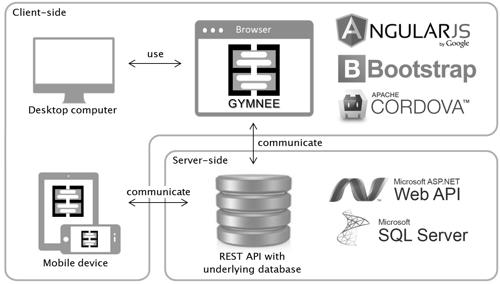GYMNEE - Digitization of fitness workouts
- Degree programme: Master of Science in Engineering
- Author: Roman Niklaus
- Thesis advisor: Prof. Marcel Pfahrer
- Expert: Dr. Philippe Büchler
- Year: 2014
Nowadays at least one gym can be found in every city and in almost every major village. The common technique offered by gyms to let members track their fitness workouts is still analog using pen and paper. Within the scope of this thesis, a software solution has been elaborated with the goal to replace the analog technique. GYMNEE makes use of mobile devices such as smartphones and tablets, and introduces an innovative approach concerning Quick Response (QR) codes.
Background and vision
A gym is a place which accommodates exercise equipment for the purpose of physical exercise. Physical exercises include any activity that enhances or maintains physical fitness, health and wellness. Explaining physical exercises to gym members, creating tailored fitness workouts fitting the needs of gym members and evaluating the progress made by gym members during a certain period is time consuming. The vision of GYMNEE is to digitize and automate all possible aspects of gym processes, and to enhance the overall gym experience.
Solution
GYMNEE is a software solution accessible from any device connected to the Internet with a web browser at disposal. Additionally, the software solution can be installed natively on any smartphone and tablet in order to make use of the embedded QR code scanner.
As a gym it is possible to manage gym members and all physical exercises digitally. The software solution automatically generates a unique QR code which can be printed and then attached to the corresponding exercise.
As a gym member it is possible to add exercises to the workout by entering the corresponding name or just by scanning the QR code. A numerical or graphical evaluation can be generated at the end of each workout or based on a longer period of time.
Implementation
The implemented software solution leverages the client-server architecture model. The server application provides an interface based on the Representational State Transfer (REST) architectural style implemented with Microsoft's ASP.NET Web API framework. This framework interacts with a Microsoft SQL Server representing the relational database management system.
The client application is a website built with HyperText Markup Language (HTML), Cascading Style Sheets (CSS) and JavaScript. It makes use of the Model-View-Controller (MVC) pattern implemented with Google's AngularJS framework. For designing purposes of the user interface, Twitter's Bootstrap framework is used.
To natively install the developed website on a mobile device such as a smartphone or tablet, Apache's Cordova (also known as PhoneGap) framework is used. Apache Cordova enables the website to access native features such as the camera which is needed in order to use the embedded QR code scanner. Supported platforms include Android, iOS (iPhone & iPad), Windows Phone and others.
The result is a fully functional prototype which will be further developed and improved after the completion of this thesis.
